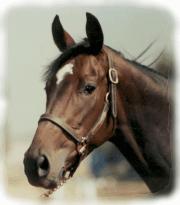
A Horse, of Course with Don Blazer |
If you enjoy learning about horses, then you'll love our online courses. Each month you'll find a new column on our web site. We hope you'll enjoy it, and maybe e-mail us with questions or suggestions for other columns. A Horse, Of Course is a monthly column syndicated by Success Is Easy. If you like the column, call your local newspaper, or local horse publication and ask them to subscribe by contacting Success Is Easy. |
What Foot Goes Where? Don Blazer copyright©2015 |

Horses are good for a lot of things. They are good to pet, and feed, and brush and blanket. But when you get right down to the nitty-gritty, they’re best for “movin’.” When mankind first met the horse he thought the horse was best for “eatin’.” But he soon discovered—every time he tried to catch a bite—the horse was best for “movin’.” Horses and mankind have been doin’ a lot of movin’ together for the past 5,000 years, and yet, amazingly few horsemen actually know how a horse moves. Sure, sure, sure he puts one foot in front of the other, and off he goes. Sure, sure, sure the muscles move the bones; but what we need to know is how them bones gonna move and where. The majority of people who own horses cannot tell you the sequence of the footfall for the walk, jog or lope; or the walk, trot and canter. There is a difference, you know, between the jog and trot, and the lope and canter, and the difference isn’t the kind of saddle on the horse’s back. The jog and lope are western gaits, in which the flight of the foot travels a more rounded arc and the horse covers less ground, essentially moving forward more slowly. Both the jog and lope are unnatural gaits and must be learned by the horse. (The western horseman wants a slow moving horse when pushing cattle so he doesn’t run all the fat off the cow and all the money out of the bank.) The flight of the foot during the trot and canter is much more natural and follows a longer, lower path. (The English rider doesn’t care about fat cows; he just wants to catch the quick, brown fox.) Even though horsemen have watched horses walk for years, most don’t seem to know how the horse does it. The most common error is thinking the horse begins walking by moving the front foot. He does not. All of a horse’s action initiates in the hindquarters. The hindquarters push the horse forward, the horse loses balance and reaches forward with a front leg to catch himself and reestablish his equilibrium. The sequence of strides at the four-beat walk might be left hind, left fore, right hind, right fore. The front foot begins moving before the hind foot strikes the ground in its new position because a god horse over-strides his front foot print with his hind foot. If the horse doesn’t over-stride, he is said to be short behind—a good indication he may have a lameness. The trot is a two-beat diagonal movement. The action is still initiated in the hindquarters, but in this case a front leg moves simultaneously. The horse may begin the trot by moving his right hind and left fore together, then the left hind and right fore together. There is no over-striding in the trot, and the horse must shorten his body and elevate the flight of the hoof. The jog is essentially a very short forward movement while the trop should have good extension. The lope or canter is a three-beat gait in which one side of the horse’s body is extended (the leading side) and the other side is contracted (the pushing side). The sequence of strides for the left lead begins with the right hind foot which takes a short (pushing) stride. The left hind and the right fore then move together. The left hind is an extended stride, while the right fore is a short stride. The final (third) beat is the left fore, which moves on a long stride. Horses also pace, which means they move both legs on the same side at the same time. Sometimes it is natural; mostly it is cultivated. If you have a horse which is not a pacer (Standardbred), and he paces, it usually means he is hurting somewhere. Some horses single-foot. A single-foot is a very smooth four-beat gait which could also be thought as a very fast walk. “Gaited” horses essentially walk, trot and canter, but with very exaggerated and flashy foot flight. There are some naturally gaited horses, although the excessive action seen in show competition can be man-enhanced. The flashy action in many competitions featuring gaited horses can be the result of painful training and shoeing techniques, not nature. The standard reply of horsemen who don’t know how a horse moves or the sequence of strides at a particular gait is, “So, what?” So the horse knows where his feet are supposed to go. But when the rider doesn’t, the horse is restricted, hindered, made to move incorrectly, and put under strain and can be injured. “That’s what!” |